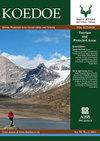南非克鲁格国家公园的首个亚米分辨率数字高程模型
IF 1.1
4区 环境科学与生态学
Q3 BIODIVERSITY CONSERVATION
引用次数: 1
摘要
数字高程模型的使用已被证明在许多与稀树草原生态系统研究相关的研究中至关重要。然而,在进行局部到区域尺度的生态系统分析时,所选择的输入数据的空间分辨率不足往往被认为是一个限制因素。本研究中创建的高程模型和正校正图像代表了为南非克鲁格国家公园(KNP)制作的第一个高空间分辨率的全墙数字高程数据集。利用来自国家地理空间信息总局(CDNGI)、农业、土地改革和农村发展部(DALRRD)航空采集计划档案的彩色红外(CIR)航空图像,我们创建了覆盖整个KNP的数字地表模型(DSMs)、数字地形模型(DTMs)和CIR正形图,标称地面采样距离为0.25 m。高程信息是通过最先进的立体匹配算法获得的,该算法利用半全局匹配(SGM)作为整个图像配对过程中的成本聚合函数,使用CATALYST的Enterprise软件。最终产物与对照品进行了验证,与0.99的R²值吻合良好。此外,DTM和DSM的验证表明,所有站点的绝对垂直高度误差(LE90)中位数分别为1.02 m和2.58 m。用原位地面控制点(gcp)验证了正测图,显示水平圆形可能误差(CPE)为1.37 m。这项工作产生的数据将免费分发,目的是在非洲科学界和其他地方促进更多的科学研究。保护意义:关于地形和地表高度的准确信息是各种科学分析的重要输入,这些分析对保护区至关重要,例如洪水预测或火灾危险估计。因此,高分辨率的高程数据集和正形图可以作为改善公园管理和促进对保护工作产生积极影响的关键工具。本文章由计算机程序翻译,如有差异,请以英文原文为准。
The first sub-meter resolution digital elevation model of the Kruger National Park, South Africa
The use of digital elevation models has proven to be crucial in numerous studies related to savanna ecosystem research. However, the insufficient spatial resolution of the chosen input data is often considered to be a limiting factor when conducting local to regional scale ecosystem analysis. The elevation models and orthorectified imagery created in this study represent the first wall-to-wall digital elevation data sets produced for the Kruger National Park (KNP), South Africa, at very high spatial resolution. Using colour-infrared (CIR) aerial imagery from the archives of the Chief Directorate: National Geo-spatial Information (CDNGI), Department of Agriculture, Land Reform and Rural Development (DALRRD) aerial acquisition programme, we created digital surface models (DSMs), digital terrain models (DTMs) and CIR orthomosaics covering the entire KNP with a nominal ground sampling distance of 0.25 m. Elevation information was derived using state-of-the-art stereo matching algorithms that utilised semi-global matching (SGM) as a cost aggregation function throughout the image pairing, using the Enterprise software from CATALYST. The final products were validated against reference products, and showed excellent agreement with R² values of 0.99. Further, the validation of the DTM and DSM revealed median absolute vertical height error (LE90) across all sites of 1.02 m and 2.58 m, respectively. The orthomosaics were validated with in situ ground control points (GCPs) exhibiting a horizontal Circular Probable Error (CPE) of 1.37 m. The data resulting from this work will be distributed freely with the aim of fostering more scientific studies in the African science community and beyond.Conservation implications: Accurate information about terrain and surface height are crucial inputs to a variety of scientific analysis, which are essential in protected areas, such as flood prediction or fire hazard estimation. Elevation data sets and orthomosaics in very high resolution can therefore serve as a crucial tool to improve park management and foster positive implications on conservation efforts.
求助全文
通过发布文献求助,成功后即可免费获取论文全文。
去求助
来源期刊

Koedoe
BIODIVERSITY CONSERVATION-
CiteScore
3.30
自引率
0.00%
发文量
10
审稿时长
20 weeks
期刊介绍:
Koedoe, with the subtitle ''African Protected Area Conservation and Science'', promotes and contributes to the scientific (biological) and environmental (ecological and biodiversity) conservation practices of Africa by defining the key disciplines that will ensure the existence of a wide variety of plant and animal species in their natural environments (biological diversity) in Africa.
 求助内容:
求助内容: 应助结果提醒方式:
应助结果提醒方式:


